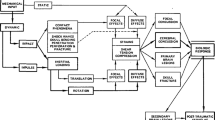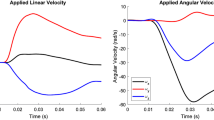Abstract
A review is presented of the existing finite-element (FE) models for the biomechanics of human head injury. Finite element analysis can be an important tool in describing the injury biomechanics of the human head. Complex geometric and material properties pose challenges to FE modelling. Various assumptions and simplifications are made in model development that require experimental validation. More recent models incorporate anatomic details with higher precision. The cervical vertebral column and spinal cord are included. Model results have been more qualitative than quantitative owing to the lack of adequate experimental validation. Advances include transient stress distribution in the brain tissue, frequency responses, effects of boundary conditions, pressure release mechanism of the foramen magnum and the spinal cord, verification of rotation and cavitation theories of brain injury, and protective effects of helmets. These theoretical results provide a basic understanding of the internal biomechanical responses of the head under various dynamic loading conditions. Basic experimental research is still needed to determine more accurate material properties and injury tolerance criteria, so that FE models can fully exercise their analytical and predictive power for the study and prevention of human head injury.
Similar content being viewed by others
References
Chan, H. S. (1974): ‘Mathematical model for closed head impact.’ Proc. 18th Stapp Car Crash Conf, Society of Automotive Engineers, Ann Arbor, Michigan, pp. 557–579
Dimasi, F. P., Eppinger, R. H., andBandak, F. A. (1995): ‘Computational analysis of head impact responses under car crash loadings.’ Proc. 39th Stapp Car Crash Conf., Society of Automotive Engineers, San Francisco, California, pp. 425–438
Frankowski, R. F., Annegers, J. F. andWhitman, S. (1985): ‘Epidemiological and descriptive studies. Part I: The descriptive epidemiology of head trauma in the United States’ inBecker, D. P. andPovlishock, J. T. (Eds.): ‘Central nervous system trauma status report’ (National Institute of Health) pp. 33–44
Fung, Y. C. (1993): ‘The application of biomechanics to the understanding of injury and healing’ inNahum, A. M. andMelvin, J. W. (Eds.): ‘Accidental injury, biomechanics and prevention’ (Springer-Verlag) pp. 1–11
Gross, A. G. (1958): ‘A new theory on the dynamics of brain concussion and brain injury,’ J. Neurosurg.,15, pp. 548–561
Hardy, C. H. andMarcal, P. V. (1973): ‘Elastic analysis of a skull,’ASME Trans., pp. 838–842
Holbourn, A. H. (1943): ‘Mechanics of head injuries,’Lancet,2, pp. 438–441
Hosey, R. R. andLiu, Y. K. (1981): ‘A homeomorphic finite element model of the human head and neck’in Simon, B. R., Gallagher, R. H., Johnson, P. c. andGross, J. F. (Eds.): ‘Finite elements in biomechanics’ (Wiley & Son) pp. 379–401
Kenner, V. H. andGoldsmith, W. (1972): ‘Dynamic loading of a fluid filled spherical shell,’Int. J. Mech. Sci.,1, pp. 557–568
Khalil, T. B., Goldsmith, W. andSackman, J. L. (1974): ‘Impact on head-helment system,’-ibid.,16, pp. 609–625
Khalil, T. B. andHubbard, R. P. (1977): ‘Parametric study of head response by finite element modelling,’J. Biomech.,10, pp. 119–132
Kumaresan, S. (1993): ‘Three dimensional finite element analysis of human head subjected to impact with and without protective layer.’ Masters Thesis, IIT, Madras, India
Kumaresan, S. andRadhakrishnan, S. (1996): ‘Importance of partitioning membranes of the brain and the neck in head injury modelling,’Med. Biol. Eng. Comput.,34, pp. 27–32
Landkof, B. andGoldsmith, W. (1976): ‘Impact on a head-neck structure,’J. Biomech.,9, pp. 141–151
Nickell, R. E. andMarcal, P. V. (1974): ‘In vacuo model dynamic response of the human skull,’J. Eng. Industry,5, pp. 490–494
Ommaya, A. K. (1968): ‘Mechanical properties of tissue of the nervous system,’J. Biomech.,1, pp. 127–138
Reber, J. B. andGoldsmith, W. (1979): ‘Analysis of large head/-neck actions,’-ibid.,12, pp. 211–222
Ruan, J. S., Khalil, T. B. andKing, A. I. (1994): ‘Dynamic response of the human head to impact by three-dimensional finite element analysis,’J. Biomech. Eng.,116, pp. 44–50
Sances, A., Jr., Myklebust, J. B., Larson, S. J., Cusick, J. F., Weber, R. C. andWalsh, P. R. (1981): ‘Bioengineering analysis of head and spine injuries,’CRC Crit. Rev. Bioeng.,2 (15), pp. 1–79
Sances, A., Jr. andYoganandan, N. (1986): ‘Human head injury tolerance’in Sances, A., Jr., Thomas, D. J., Ewing, C. L., Larson, S. J., Unterharnscheidt, F. (Eds.): ‘Mechanisms of head and spine trauma.’ (Aloray, Goshen, New York), pp. 189–218
Shugar, T. A. (1975): ‘Transient structural response of the linear skull-brain system.’ Proc. 19th Stapp Car Crash Conf., Society of Automotive Engineers, San Diego, California, 581–614
US Department of Health and Human Services. (1989). ‘Healthy people 20000—National health promotion and disease prevention objectives.’ p. 692
Ward, C. C. (1982): ‘Finite element models of the head and their use in brain injury research’ Proc. 26th Stapp Car Crash Conf., Society of Automotive Engineers, Ann Arbor, Michigan, pp. 71–85
Wood, J. L. (1971): ‘Dynamic response of human cranial bone,’J. Biomech.,4, pp. 1–12
Yoganandan, N., Pintar, F. A., Sances, A. Jr., Walsh, P. R., Ewing, C. L., Thomas, D. L. andSnyder, R. G. (1995): ‘Biomechanics of skull fracture,’J. Neurotrauma,12, (4), pp. 659–668
Author information
Authors and Affiliations
Rights and permissions
About this article
Cite this article
Voo, L., Kumaresan, S., Pintar, F.A. et al. Finite-element models of the human head. Med. Biol. Eng. Comput. 34, 375–381 (1996). https://doi.org/10.1007/BF02520009
Received:
Issue Date:
DOI: https://doi.org/10.1007/BF02520009




